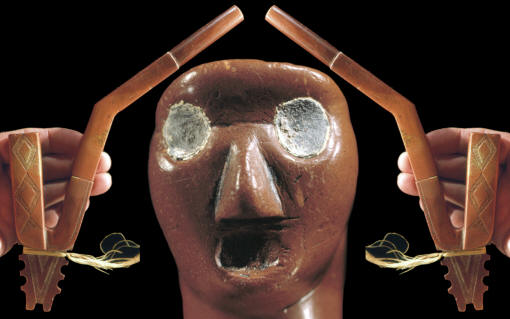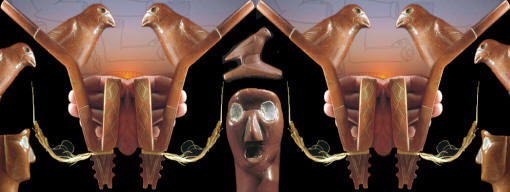|
"Smoking was a
custom of great moment among the aborigines of northern America, and
much time and labor were expended in the manufacture and decoration of
the tobacco pipe, which is often referred to as "the sacred calumet,"
because of its important place in the ceremonial affairs of the people."---1919,
Frederick Webb Hodge, "Catlinite," Handbook of American
Indians North Of Mexico, part 1, p. 217.
"A favorite material for the manufacture
of tobacco pipes and various articles of ornament, sacred, and
ceremonial use was the red claystone called catlinite, obtained from a
quarry in southwestern Minnesota, and so named because it was first
brought to the attention of mineralogists by George Catlin."---1919,
W. H. Holmes, "The Red Pipestone Quarry," Handbook of American
antiquities, Part I, Introductory The Lithic Industries, p. 253.
"To the Indian
of the old school, the one who is still a devout believer in the dream
and medicine dances, and who sees the head of the supernatural in many
phases of his daily life, tobacco may be said to be used, even at the
present day, in a strictly religious manner."---1911,
S. A. Barrett, "Smoking Customs," The Dream Dance Of The
Chippewa And Menominee Indians Of Northern Wisconsin, Bulletin,
Public Museum, Milwaukee, Vol. 1, p. 360.
"Catlinite is reported as having been found in
Indian graves of New York, and in Georgia, more than twelve hundred
miles from the quarry."---1934,
George A. West, "Methods Of Manufacture Of Aboriginal Pipes,"
Tobacco, Pipes And Smoking Customs Of The American Indians, p. 334.
"The Oneota culture is closely similar to what
McKern designates for Wisconsin as the Mississippi Upland focus, Upper
Mississippi phase, the characteristic pipes of which are the disc and
possibly the Diminutive Siouan types"---1934,
George A. West, "Pipes From Iowa," Tobacco, Pipes And Smoking Customs
Of The American Indians, p. 288.
"At a meeting of the American Philosophical
Society in 1866 Hayden stated that in the two years just passed the
Northwestern Fur Co. had manufactured nearly 2,000 (catlinite) pipes and
traded them with the tribes of the upper Missouri"---1919,
W. H. Holmes, "The Red Pipestone Quarry," Handbook of American
antiquities, Part I, Introductory The Lithic Industries, p. 263.

CATLINITE PIPES
EAST OF THE ROCKIES
MIDDLE WOODLAND TO HISTORIC PERIOD
Catlinite pipes of every imaginable design have been discovered on sites
across the United States, mainly east of the Rocky Mountains. The study
of catlinite pipes is a complex one because so many different Native
American Indian tribes, both recent and ancient, have been making them for
so long. Plus the fact that large numbers of them were also made by
Europeans, during he fur trading years.
|
|
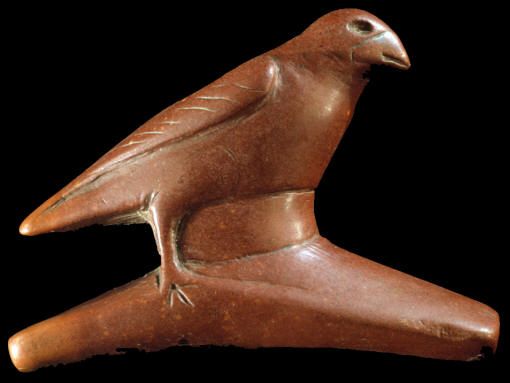
PRIVATE COLLECTION
PLATFORM PIPE
HOPEWELL CULTURE
MADISON COUNTY, ILLINOIS
This bird effigy platform pipe represents one of the earliest
examples of catlinite pipes. Although, some examples of catlinite
tube pipes have been reported from the Early Woodland period. This
pipe was discovered during levy construction in Madison County,
Illinois sometime in the mid 1800's. It has been illustrated in
several publications, including "The History Of Madison County."
This pipe dates to approximately 1600 years before present. |
|
|
Red catlinite
has been a favorite pipe making material for hundreds of years. Other
names used to describe it are, pipestone, claystone, red claystone and
pipeclay. Catlinite is described as a fine-grained argillaceous
sediment, metamorphosed mudstone and indurated clay. Catlinite was named
after George Catlin who observed the site in 1835. |
|
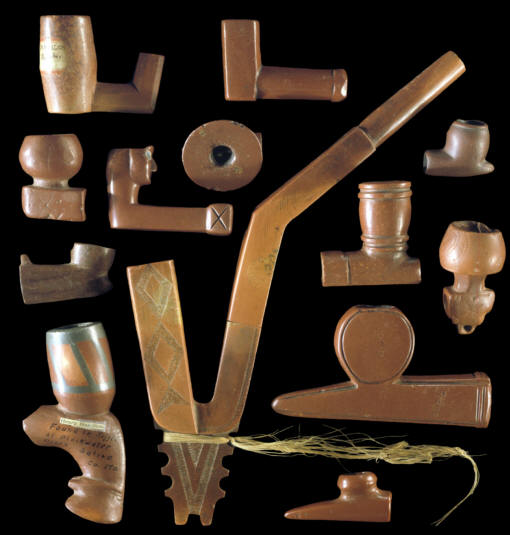
PRIVATE COLLECTION
CLICK ON PICTURE FOR LARGER IMAGE
CATLINITE PIPES
NORTH CENTRAL UNITED STATES
EST. 1450 TO 1900 A.D.
All of the pipes in this picture are made of
catlinite from the ancient pipestone quarry site near Pipestone,
Minnesota. They vary in age from 1450 to 1900 A.D. The oldest pipe
is the disc pipe located at top center. It dates to the Late
Mississippian period sometime between 1450 and 1640 A.D. A more
recent pipe is the bison leg effigy pipe at lower left that dates to
the latter half of the 1800's to 1900. Some of these pipes were
found in either cultivated fields or drainage areas such as creeks
and rivers. Others were purchased directly from tribal
members. The large Menominee pipe in the center was found in a tool
box at an estate sale. Most of these pipes were collected in the
north central states of Iowa, Wisconsin, Missouri and Illinois. They
were made by Native American Indians who used them either for
personal use or trade and by Europeans who used large numbers of
them for the fur trade. Most of these pipes show signs of having
been smoked and they also would have had pipe stems. They range in
size from 1 5/16 inches (3.3 cm) to 10 1/2 inches (26.6 cm) long. |
|
|
The source for this
highly desirable pipe making material is the pipestone quarry located
near the town of Pipestone in Pipestone County, Minnesota. The site is
now preserved in Pipestone National Monument. Only enrolled Native
American Indians are allowed to quarry the stone. Quarrying is done by
hand to protect the site from over-mining. |
|

PRIVATE COLLECTION
DISC PIPE
ARKANSAS
LATE MISSISSIPPIAN CULTURE
EST. AGE 1450 - 1600 A.D.
This very large disc pipe was discovered on a site in Arkansas. It
dates to the Late Mississippian period sometime between 1450 and
1600 A.D. This is an exceptionally fine
example. |
|
|
Catlinite is a claystone that is especially well suited for pipes. Its
color varies from light gray to pale and dark reds. Some catlinite is
mottled and spotted with a lighter color against a darker color.
Catlinite is easy to carve with a metal knife, file or even stone tools. |
|
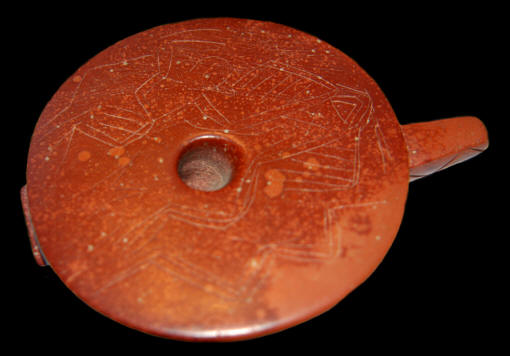
WAGERS FAMILY COLLECTION
DISC PIPE
MISSISSIPPIAN CULTURE
EST. AGE 1450 - 1600 A.D.
This large disc pipe was found
several years ago in Lawrence County, Arkansas. It was discovered on
the surface of a cultivated field by a boy on the Gibson site. There
have been a few large disc pipes found with engraving. This pipe is
engraved with zigzag and parallel lines on the upper surface of the
disc. It measures 4 1/2 inches (11.4 cm) long and 3 1/2 inches (8.9
cm) wide. |
|
|
The pipestone bearing stratum varies from 10 to 20 inches thick but the
band of pure, fine-grained catlinite rarely measures more than 3 to 4
inches thick. The layer of catlinite is below a layer of quartzite, soil
and debris from previous digging. The earliest mining activities were
done with stone tools. For most of the last two hundred years the
quarrying has been done with picks, bars and hammers made of iron.
It's reported that originally there was a
line of ancient pits from ten to twenty feet deep that extended for
about a mile along a low ridge. These ancient pits were eventually
obliterated by later excavations. |
|
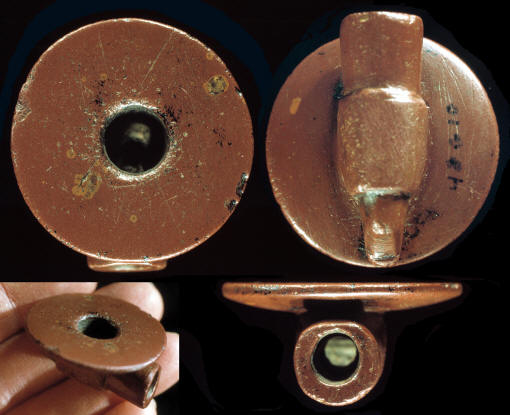
PRIVATE COLLECTION
CLICK ON PICTURE FOR LARGER IMAGE
DISC PIPE
ONEOTA CULTURE
EST. AGE 1450 - 1650 A.D.
This small Oneota culture disc pipe
was found several years ago in Missouri. It dates to the Late
Mississippian Period sometime between 1450 and 1650 A.D.
The
Oneota culture
is the name given by archaeologists to several late prehistoric
farming peoples of the upper Midwestern United States from Illinois,
Iowa, Minnesota, Wisconsin, and into Manitoba, Missouri, and
Nebraska. This pipe would also have needed an additional pipe stem
to smoke it. It measures 1 9/16 inches (3.9 cm) long and 1 1/2
inches (3.8 cm) wide. |
|
|
The earliest catlinite pipes were made during the Woodland Period in the
form of tube and platform pipes. The tube pipes were made during the
Early Woodland Period between 2500 and 2000 years ago. Only a handful
them have been found. The Middle Woodland (Hopewell) Period also
produced several examples of platform pipes between 2000 and 1600 years
ago. One well documented example in the form of a standing bird is
illustrated in the article. |
|
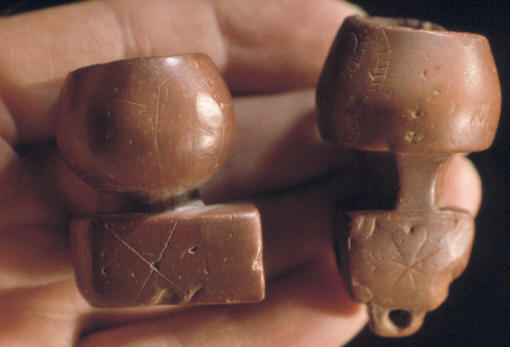
PRIVATE COLLECTION
MICMAC PIPES
ILLINOIS AND MISSOURI
Micmac pipes are famous for their wide distribution area. George
West wrote in 1905 that "Specimens of the Micmac type of pipe are
found as far south as Georgia and from the Atlantic Ocean to the
Rocky mountains." The bowls of these pipes are described as being in
the shape of an inverted acorn. The bowl sits on top of a keel-like
base which is widest where it touches the bowl. The pipe on the
right in this picture is a classic example. It has a perforated
base that probably once held some type of attachment such as a
natural fiber cord or feathers. It's also engraved with four hearts
on both sides which may be an Osage design. The unperforated pipe on
the left was found in 1880 in Randolph County, Illinois and it may be an early example of a Micmac pipe. West wrote that
some of the unperforated pipes probably represent the older forms.
This pipe also has an X engraved on one side. Both of these pipes
would have once had a pipe stem. The larger of the two pipes
measures 2 1/8 inches (5.4 cm) long. |
|
|
The next most productive period of catlinite pipe manufacturing occurred
during the Late Mississippian Period between 550 and 350 years ago. Most
of these are in the form of large and small disc pipes. The Late
Mississippian and Early Historic Period Utz site, in Saline County,
Missouri, produced 135 disc pipes, of which 63 were made of catlinite.
Forty two were made of limestone, 26 of shale, 2 of granite, 1 of
hematite and 1 of greenstone. The largest disc pipes, made during this
period, represent some of the most skillfully crafted and visually
impressive pipes ever made of catlinite. |
|
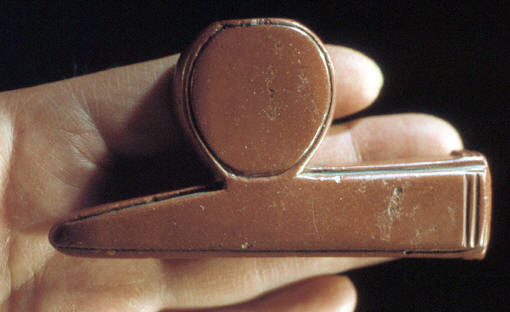
PRIVATE COLLECTION
VERTICAL DISC PIPE
IOWA
This pipe is believed to have been purchased several years ago from
a member of the Meskwaki tribe in Iowa. It represents a rare form
vertical-disc pipe. It's decorated on all the edges with deeply
engraved lines and parallel lines on all four sides near the stem.
The parallel lines at top and bottom are slightly raised. This pipe
would have once had an attached pipe stem. It measures 4 1/8 inches
(10.4 cm) long. |
|
|
Late
Mississippian disc pipes have turned up far and wide across the United
States east of the Rockies. Three widely separated finds that were
discovered on sites not occupied by Oneota groups are: One from the Reed
Fort site in Ontario County, New York in a pre-contact burial. Another
example was discovered at Spiro Mound in Le Flore County, Oklahoma and
another was discovered on the Demery site in Corson County, South
Dakota. |
|
CONTINUE ON TO PAGE
TWO
|
|
"REFERENCES"
1899, McGuire, Joseph D., "Pipes And
Smoking Customs Of The American Aborigines, Based On Material In The
U.S. National Museum," Annual Report, Smithsonian Institution, Part 1,
p. 361.
1905, West, George A., "The Aboriginal Pipes Of Wisconsin," The
Wisconsin Archaeologist, Vol. 4, Nos. 3 & 4, p.50 & 92-97 & 130-141.
1911, Barrett, S. A., "Smoking
Customs," The Dream Dance Of The
Chippewa And Menominee Indians Of Northern Wisconsin, Bulletin,
Public Museum, Milwaukee, Vol. 1, p. 360.
1919, Hodge, Frederick Webb "Catlinite," and "Calumet," Handbook of American
Indians North Of Mexico, part 1, pp. 191-195 & 217.
1919, Holmes, W. H., "The Red Pipestone Quarry," Handbook of American
antiquities, Part I, Introductory The Lithic Industries, pp.
253-264.
1934, West, George A., "Methods Of Manufacture Of Aboriginal
Pipes,"
Tobacco, Pipes And Smoking Customs Of The American Indians, p. 334 &
834.
1967, Hamilton, Henry W., "Tobacco Pipes Of The Missouri
Indians," pp. 1-42.
Personal Communication, Dennis Vesper.
Personal Communication, Charley Wagers.
Personal Communication, Bruce Filbrandt.
Personal Communication, Ray Fraser
|
|
RECENT
LISTINGS HOME
ORDERING |
